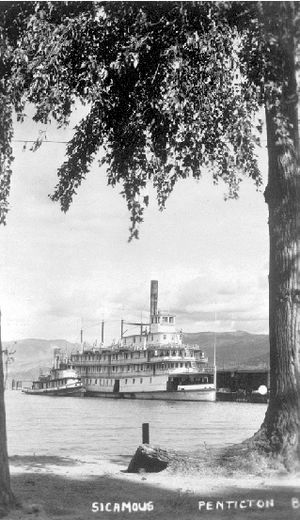SS Naramata facts for kids

SS Naramata and SS Sicamous at Penticton, 1920
|
|
| History | |
|---|---|
| Namesake | Naramata |
| Owner |
|
| Builder | Western Dry Dock and Shipbuilding Company |
| Cost | CA$43,000 |
| Completed | 20 April 1914 |
| Out of service | August 1967 |
| Status | Museum ship |
| General characteristics | |
| Tonnage | 149.94 GT (73.67 registered) |
| Length | 98 ft (30 m) LOA (89.8 ft (27.4 m) registered) |
| Beam |
|
| Height | 53 ft (16 m) |
| Draught | 5.5 ft (1.7 m) |
| Depth | 8 ft (2.4 m) |
| Installed power |
|
| Propulsion |
|
| Speed |
|
The SS Naramata is a special steam tugboat. It was built for the Canadian Pacific Railway (CPR) company. This strong boat helped move things and break ice on Okanagan Lake. It worked from 1914 all the way to 1967. That's over 50 years of service! After its long career, the Naramata was retired. It now rests in Penticton next to its sister ship, the SS Sicamous. In 2001, a group called the S.S. Sicamous Restoration Society bought it. They are working hard to fix it up. The Naramata is the only steam tugboat from inland British Columbia, Canada, that has been saved.
Contents
Building the Naramata
The Naramata was built for the CPR. Its main parts, like the hull, engine, boiler, and steel fittings, were made in Port Arthur, Ontario. This city is now called Thunder Bay. The Western Dry Dock and Shipbuilding Company built these parts. Then, everything was sent to Okanagan Landing to be put together.
Work on the Naramata started in September 1913. It was finished by April 20, 1914. The total cost to build the ship was CA$43,000. It was named after the lovely village of Naramata. This town was famous for growing a lot of the fruit in the valley back then.
Who Worked on the Ship?
The Naramata usually had 11 to 13 people working on it. This included a captain or first officer, a pilot, and two deckhands. There was also a chief engineer, a second engineer, and two firemen. A bargeman and a cook, who also helped as a steward, completed the crew.
This ship was the first on Okanagan Lake to have a flushing toilet. It even had a working shower! Because the job was often dirty, the crew had to shower at least once a week. People often joked that the crew members were some of the "cleanest and dirtiest" on the lake!
What the Naramata Did
The Naramata sometimes carried people, up to 22 passengers at a time. But its main job was as a tugboat for the Canadian Pacific Railway. CPR tugboats did two important things. They pushed and pulled barges that were full of valuable goods. Also, in winter, they acted as icebreakers. They would clear a path for other, larger passenger ships, which often had wooden hulls.
The Naramata would often go ahead of the Sicamous. Its crew would leave a trail of cardboard to mark the clear path through the ice. But most of the time, the Naramata was used for moving barges. CPR tugboats could push up to two barges at once. Each barge could hold up to ten train cars! This was a big job. When moving two barges, the Naramata would fit between them at the back. This created a "V" shape that made it easy to steer. Sometimes, the barges were also pulled from behind the tugboat.
The Naramata's Retirement
The Naramata stopped working in August 1967. After it retired, it stayed at Okanagan Landing. Over the years, different groups owned it.
Saving and Restoring the Ship
In 1991, the Naramata was sold to the Kettle Valley Railway Heritage Society and the City of Penticton. On October 1st of that year, it was moved to Penticton. It floated next to the Sicamous until 1993. Then, people found that the hull was rusting. To stop it from sinking, the ship was immediately moved onto the shore. As of 2014, it sits in a pool of water. The hope is to move it permanently next to the Sicamous.
In 2001, the S.S. Sicamous Restoration Society bought the Naramata. By 2003, they started cleaning and fixing the damaged ship. This included removing three tons of coal and asbestos, which are harmful materials. They also did general carpentry and safety repairs. A steel staircase was added to make it easier for people to visit.
In 2004, the Society received a CA$90,000 grant. This money came from the Western Economic Diversification Fund, a government program. This allowed for more restoration work. The ship got a deep cleaning and a fresh coat of paint. After that, the pilothouse (where the ship is steered) and some crew cabins were fixed. Many windows were replaced, and a security system was put in place.

